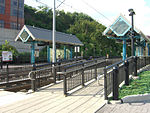Hook and Ladder No. 3
Buildings and structures in Jersey City, New JerseyDefunct fire stations in New JerseyFire stations completed in 1896Fire stations on the National Register of Historic Places in New JerseyNational Register of Historic Places in Hudson County, New Jersey ... and 2 more
New Jersey Register of Historic PlacesNew Jersey Registered Historic Place stubs

Hook and Ladder No. 3 is a historic fire station located at 218 Central Avenue in the Jersey City Heights section of Jersey City in Hudson County, New Jersey. It was added to the National Register of Historic Places on August 24, 2015, for its significance in architecture and politics/government from 1896 to 1964. The fire station was closed in 2005.
Excerpt from the Wikipedia article Hook and Ladder No. 3 (License: CC BY-SA 3.0, Authors, Images).Hook and Ladder No. 3
Ferry Street, Jersey City
Geographical coordinates (GPS) Address Nearby Places Show on map
Geographical coordinates (GPS)
| Latitude | Longitude |
|---|---|
| N 40.741944444444 ° | E -74.051944444444 ° |
Address
Ferry Street at Central Avenue
Ferry Street
07307 Jersey City
New Jersey, United States
Open on Google Maps









